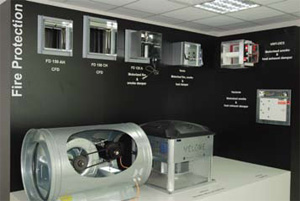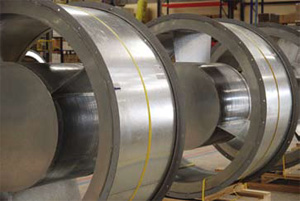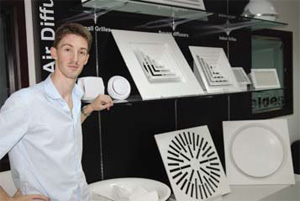Climate Control Middle East visits the Aldes Middle East factory, which opened in the thick of the downturn and is determined to see the tough times through.
Climate Control Middle East visits the Aldes Middle East factory, which opened in the thick of the downturn and is determined to see the tough times through. Photographs: B Surendar
 It is early July, and the weather is unrelenting. Protected from the sun, though, a group of workers are beavering away near a batch of circular sound attenuators, in the Aldes Middle East factory, in Sharjah International Airport Free Zone.
It is early July, and the weather is unrelenting. Protected from the sun, though, a group of workers are beavering away near a batch of circular sound attenuators, in the Aldes Middle East factory, in Sharjah International Airport Free Zone.
The attenuators, destined for Qatar, are large – 1.8 metres in diameter, imposing and command attention. But in relation to the 8,000-square-metre expanse of the factory, they look small.
The factory, which opened early this year, consists of three sections: a cutting section, a steel assembly section and an aluminium assembly section. It is here that Aldes makes 85% of its products for the GCC market. The range includes fire dampers (motor and smoke), VAVs, VCDs, sound attenuators, grilles, diffusers and louvres.

Gaetan Pierrefeu
In addition to standard specifications, the factory produces non-standard, customised items. The circular sound attenuators bound for Qatar, in two batches of 40 each, are examples of customisation. “It is common for us to produce customised items,” says Gaetan Pierrefeu, the Managing Director of Aldes Middle East. Sometime ago, we delivered similar large sound attenuators to a big project in Fujairah. Customising seems to be important for customers here.”
Owing to the demand for customisation, Pierrefeu says, it is impossible to ascertain how many products the factory can produce every day. In the case of the batch for Qatar, owing to the size, the shop floor personnel can produce four a day. If square in shape, they will be able to produce 25 a day, Pierrefeu says. Likewise, in the case of an order for 2,000 VAVs with five dimensions, the factory can produce 200 pieces a day; however, at times, it gets an order involving 50 dimensions, which makes it impossible to determine the number of pieces the factory can produce in a day. “Customisation is our strength, though,” Pierrefeu says. “We don’t manage workflow based on the number of items we need to produce. One week to another, the production organisation is completely changing.”
Keeping this in mind, Pierrefeu is trying to develop minimum skills levels for the personnel, so that he is in a position to move people from producing sound attenuators to VAVs. “Flexibility is key,” Pierrefeu says. “In sound attenuators, you don’t have a lot of welding, but fire dampers and VCDs demand a lot of welding.”
 Flexibility is important from an employability point of view, as well. Since it is possible for the shop floor personnel to migrate from one task to another, the factory is able to avoid wastage of human resources, Pierrefeu says. This is particularly crucial in the downturn – it is able to maintain production with a leaner workforce.
Flexibility is important from an employability point of view, as well. Since it is possible for the shop floor personnel to migrate from one task to another, the factory is able to avoid wastage of human resources, Pierrefeu says. This is particularly crucial in the downturn – it is able to maintain production with a leaner workforce.
Planning for the factory started in the end of 2006. Construction started in 2007, and 90% of the factory became ready by the middle of 2009. At the time of planning, Aldes and Pierrefeu did not anticipate the severity of the downturn. Today, Pierrefeu admits that the downturn is impacting the factory. “Compared to initial plans, the production capacity is three times what we are currently doing,” he says, looking rueful. “The market is down in Dubai, so we are working on the northern Emirates and Abu Dhabi.”
A saving grace at this point in time is Qatar, says Pierrefeu. “Qatar is booming for us,” he says. “We have multiplied our sales by three in Qatar. As for Saudi Arabia, it is the next big market. As of now, we are almost zero with regards to Saudi Arabia, though.”
 The downturn, Pierrefeu says, is all the more challenging, because people are price-oriented. In his view, a lot of people have invested capital in setting up factories that manufacture similar products, which has led to oversupply of the products. However, most of those products are not reliable, Pierrefeu says. “We, too, make our products locally, but we have a good technical approach. What is missing in the market is regulation, and that’s impacting us.” Pointing to the example of France, Pierrefeu says that while designing a school there, it is mandatory to have air renewals at five times an hour for a standardsized classroom. This will determine the type of grilles and fans, the dimensions of ducting and the performance of the system. A grille is not just a grille; it directs and regulates air flow.”
The downturn, Pierrefeu says, is all the more challenging, because people are price-oriented. In his view, a lot of people have invested capital in setting up factories that manufacture similar products, which has led to oversupply of the products. However, most of those products are not reliable, Pierrefeu says. “We, too, make our products locally, but we have a good technical approach. What is missing in the market is regulation, and that’s impacting us.” Pointing to the example of France, Pierrefeu says that while designing a school there, it is mandatory to have air renewals at five times an hour for a standardsized classroom. This will determine the type of grilles and fans, the dimensions of ducting and the performance of the system. A grille is not just a grille; it directs and regulates air flow.”

Alexandre Benoit
Regulation is not just about the product, adds Pierrefeu’s colleague and Marketing Manager of the company, Alexandre Benoit. It is also about whether the product is properly installed or not. “The regulation for ventilation started 40 years ago in France,” he says. “Regulation defines how much air should be extracted from a toilet or a kitchen. It defines a minimum level of working conditions, a minimum level of quality
Copyright © 2006-2025 - CPI Industry. All rights reserved.